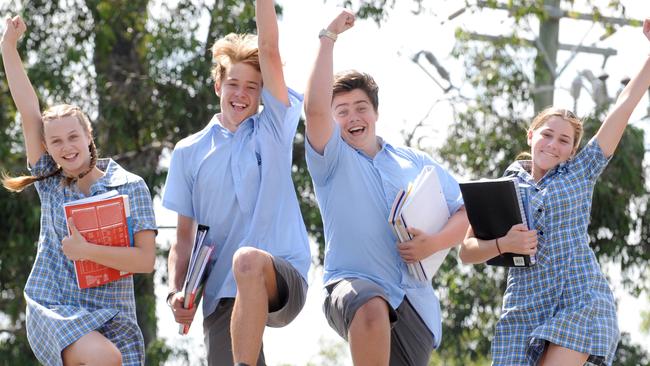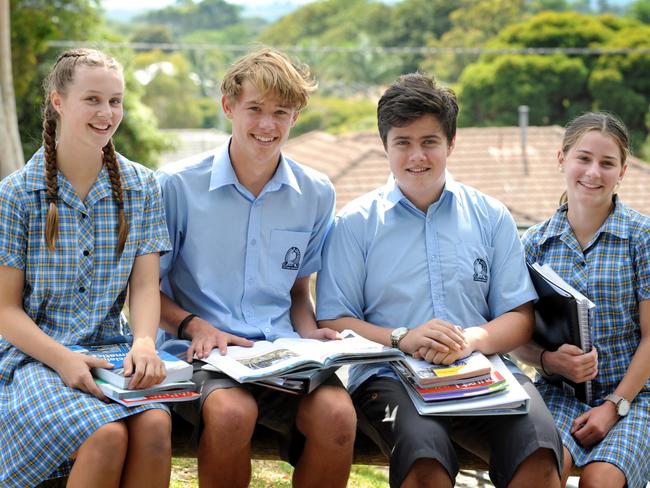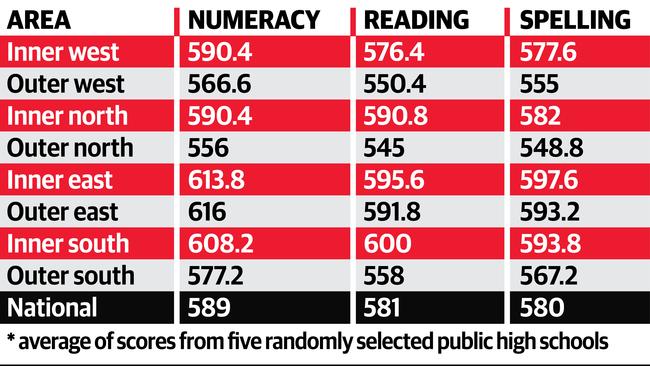NAPLAN: Results show city divide at Melbourne’s public high schools
PUBLIC high schools in Melbourne’s inner south and east are leading the city’s literacy and numeracy scores. See how your area fares.

VIC News
Don't miss out on the headlines from VIC News. Followed categories will be added to My News.
- Migrants outclass Aussie students in NAPLAN
- Alarm over NAPLAN emoji text questions
- Naplan report card shows major fail
- Photo during NAPLAN test among breaches
PUBLIC high schools in Melbourne’s inner south and east are leading the city’s literacy and numeracy scores.
But NAPLAN results show colleges in the outer north and west are lagging with some below national averages.
A Herald Sun analysis of year 9 scores at 40 Melbourne state schools shows a divide across the city.
An average of numeracy, reading and spelling scores from five public high schools in the inner east trumped the national average.
Random samples in the inner south, covering Brighton and Albert Park, and the outer east, including Blackburn and Glen Waverley, also returned strong scores.
An average of results from five selected schools in the inner north and west were on par with national averages.
The assortment of schools in the outer south recorded a mean score in numeracy, reading and spelling below the average Australia-wide.
But the lowest average scores were from samples of schools on the city’s northern and western fringes.
Frankston High School returned the highest results in numeracy, reading and spelling in a random sample of schools in the outer south.

The school crunches NAPLAN data each year to identify any weaknesses and then approaches similar schools that performed better to learn how they achieved the results.
“With NAPLAN we can identify our strengths but also the common weaknesses among the cohorts,” principal John Albiston said.
“We want to constantly improve so it’s really helpful to compare yourself with other similar schools and learn from each other.”
The MySchool website today released individual school results from last year’s NAPLAN that tested year 3, 5, 7 and 9 students on reading, writing, grammar and punctuation, spelling and numeracy.
Australian Curriculum Assessment and Reporting Authority boss Robert Randall said parents could scrutinise the results of schools they were interested in.

The authority also identified 400 schools across Australia that had recorded significant improvements.
“On average, our results are plateauing or stable but we do know that efforts at schools across the country are leading to improved results,” Mr Randall said.
Orrvale Primary near Shepparton, Holy Eucharist in St Albans and Mossgiel Park Primary in Endeavour Hills all posted gains in both literacy and numeracy.
Dimboola Primary School and Murtoa College were among the most improved schools for reading, while the numbers favoured Thornbury Primary, St Albans Secondary and Braybrook College for numeracy improvements.
Donburn Primary School in Doncaster East boosted numeracy scores with a program pairing experienced teachers with younger colleagues to show “how to explicitly teach maths principles”.
“Teachers come out of uni with general knowledge but those teachers with years of experience can add to the expertises of others,” principal Julie Hoskin said.
KIDS’ PEN ’n’ PAPER TRAVAILS
BY MONIQUE HORE
A LITERACY expert has warned the move to online NAPLAN tests could favour wealthy and well-resourced schools whose students are used to working on computers.
The transition to online assessments begins in May when about 10 per cent of Australian schools log on for the national tests.
The remaining schools will move to the online tests over the following two years.
But author and literacy expert Louise Park said students at schools that preferred pen and paper to iPads would have “to contend” with the computers as well as the test.
“I’m worried that private schools — and well-equipped public schools — might do really well because the students have been using computers and tablets every day, whereas students in other schools haven’t,” said Ms Park, an ambassador for BIC Australia’s Bright Futures Are Written By Hand program.
Concerns were raised last year that year 3 students were too young for the online assessment and that the results would be influenced by inconsistent keyboard abilities. Australian Curriculum Assessment and Reporting Authority boss Robert Randall said the online test would provide “better assessment and more precise results”.
NAPLAN paper tests will run from May 9-11, with the online assessments May 9-19.


